Customer Churn
1. Business Problem:
We are looking at a subscription model business for a bank where subscription is the primary source of revenue with different sources. The companies try to minimize the customer churn - Cancel subscription to retain their customers. In this business problem, we will look into customer behavior pattern to know the disengagement pattern with the product
1.1 Problem statement
The object is to know which users are like to cancel the subscription. It will help to focus on re-engaging these users with the product. It can be a generic e-mail to explain the benefits of products, focus on user value. We need to careful to only connect with users who will stay with reminder, not leave after the reminder.
1.2 Source
Data is shared for learning and doesn’t reperesnt real customer in any form
1.3 Business objective / Constraints
- Cost of misclassification (churn or not churn) is high
- No strict Latency
- Interpretability is important for Marketing / Product Managers
2. Machine Learning Problem
As it is clear, we would like to use ML in this business problem.
2.1 Type of Machine Learning Problem
It is a classic case of classification problem - to be precise, it’s a case of binary classification.
2.2 Performance metrics
We would like to be measure how accuracte is our model and also how precise it is. Mainly, Would like to see F-1 Score as metrics
2.3 Data
#### Importing Libraries ####
import pandas as pd
import matplotlib.pyplot as plt
import numpy as np
import seaborn as sns
import warnings
warnings.filterwarnings('ignore')
dataset = pd.read_csv('churn_data.csv')
dataset.head()
| user | churn | age | housing | credit_score | deposits | withdrawal | purchases_partners | purchases | cc_taken | ... | waiting_4_loan | cancelled_loan | received_loan | rejected_loan | zodiac_sign | left_for_two_month_plus | left_for_one_month | rewards_earned | reward_rate | is_referred | |
|---|---|---|---|---|---|---|---|---|---|---|---|---|---|---|---|---|---|---|---|---|---|
| 0 | 55409 | 0 | 37.0 | na | NaN | 0 | 0 | 0 | 0 | 0 | ... | 0 | 0 | 0 | 0 | Leo | 1 | 0 | NaN | 0.00 | 0 |
| 1 | 23547 | 0 | 28.0 | R | 486.0 | 0 | 0 | 1 | 0 | 0 | ... | 0 | 0 | 0 | 0 | Leo | 0 | 0 | 44.0 | 1.47 | 1 |
| 2 | 58313 | 0 | 35.0 | R | 561.0 | 47 | 2 | 86 | 47 | 0 | ... | 0 | 0 | 0 | 0 | Capricorn | 1 | 0 | 65.0 | 2.17 | 0 |
| 3 | 8095 | 0 | 26.0 | R | 567.0 | 26 | 3 | 38 | 25 | 0 | ... | 0 | 0 | 0 | 0 | Capricorn | 0 | 0 | 33.0 | 1.10 | 1 |
| 4 | 61353 | 1 | 27.0 | na | NaN | 0 | 0 | 2 | 0 | 0 | ... | 0 | 0 | 0 | 0 | Aries | 1 | 0 | 1.0 | 0.03 | 0 |
5 rows × 31 columns
2.3.1 Data Column details
- userid - MongoDB userid
churn - Active = No Suspended < 30 = No Else Churn = Yes - age - age of the customer
- city - city of the customer
- state- state where the customer lives
- postal_code - zip code of the customer
- zodiac_sign- zodiac sign of the customer
- rent_or_own - Does the customer rents or owns a house
- more_than_one_mobile_device - does the customer use more than one mobile device
- payFreq- Pay Frequency of the cusomter
- in_collections - is the customer in collections
- loan_pending - is the loan pending
- withdrawn_application - has the customer withdrawn the loan applicaiton
- paid_off_loan- has the customer paid of the loan
- did_not_accept_funding - customer did not accept funding
- cash_back_engagement - Sum of cash back dollars received by a customer / No of days in the app
- cash_back_amount - Sum of cash back dollars received by a customer
- used_ios- Has the user used an iphone
- used_android - Has the user used a android based phone
- has_used_mobile_and_web - Has the user used mobile and web platforms
- has_used_web - Has the user used MoneyLion Web app
- has_used_mobile - as the user used MoneyLion app
- has_reffered- Has the user referred
- cards_clicked - How many times a user has clicked the cards
- cards_not_helpful- How helpful was the cards
- cards_helpful- How helpful was the cards
- cards_viewed- How many times a user viewed the cards
- cards_share- How many times a user shared his cards
- trivia_view_results-How many times a user viewed trivia results
- trivia_view_unlocked- How many times a user viewed trivia view unlocked screen
- trivia_view_locked - How many times a user viewed trivia view locked screen
- trivia_shared_results- How many times a user shared trivia results
- trivia_played - How many times a user played trivia
- re_linked_account- Has the user re linked account
- un_linked_account - Has the user un linked account
- credit_score - Customer’s credit score
3. Exploration Data Analysis (EDA)
# Viewing the Data
dataset.head(5)
| user | churn | age | housing | credit_score | deposits | withdrawal | purchases_partners | purchases | cc_taken | ... | waiting_4_loan | cancelled_loan | received_loan | rejected_loan | zodiac_sign | left_for_two_month_plus | left_for_one_month | rewards_earned | reward_rate | is_referred | |
|---|---|---|---|---|---|---|---|---|---|---|---|---|---|---|---|---|---|---|---|---|---|
| 0 | 55409 | 0 | 37.0 | na | NaN | 0 | 0 | 0 | 0 | 0 | ... | 0 | 0 | 0 | 0 | Leo | 1 | 0 | NaN | 0.00 | 0 |
| 1 | 23547 | 0 | 28.0 | R | 486.0 | 0 | 0 | 1 | 0 | 0 | ... | 0 | 0 | 0 | 0 | Leo | 0 | 0 | 44.0 | 1.47 | 1 |
| 2 | 58313 | 0 | 35.0 | R | 561.0 | 47 | 2 | 86 | 47 | 0 | ... | 0 | 0 | 0 | 0 | Capricorn | 1 | 0 | 65.0 | 2.17 | 0 |
| 3 | 8095 | 0 | 26.0 | R | 567.0 | 26 | 3 | 38 | 25 | 0 | ... | 0 | 0 | 0 | 0 | Capricorn | 0 | 0 | 33.0 | 1.10 | 1 |
| 4 | 61353 | 1 | 27.0 | na | NaN | 0 | 0 | 2 | 0 | 0 | ... | 0 | 0 | 0 | 0 | Aries | 1 | 0 | 1.0 | 0.03 | 0 |
5 rows × 31 columns
## Data columns
dataset.columns
Index(['user', 'churn', 'age', 'housing', 'credit_score', 'deposits',
'withdrawal', 'purchases_partners', 'purchases', 'cc_taken',
'cc_recommended', 'cc_disliked', 'cc_liked', 'cc_application_begin',
'app_downloaded', 'web_user', 'app_web_user', 'ios_user',
'android_user', 'registered_phones', 'payment_type', 'waiting_4_loan',
'cancelled_loan', 'received_loan', 'rejected_loan', 'zodiac_sign',
'left_for_two_month_plus', 'left_for_one_month', 'rewards_earned',
'reward_rate', 'is_referred'],
dtype='object')
## Data describe
dataset.describe()
| user | churn | age | credit_score | deposits | withdrawal | purchases_partners | purchases | cc_taken | cc_recommended | ... | registered_phones | waiting_4_loan | cancelled_loan | received_loan | rejected_loan | left_for_two_month_plus | left_for_one_month | rewards_earned | reward_rate | is_referred | |
|---|---|---|---|---|---|---|---|---|---|---|---|---|---|---|---|---|---|---|---|---|---|
| count | 27000.000000 | 27000.000000 | 26996.000000 | 18969.000000 | 27000.000000 | 27000.000000 | 27000.000000 | 27000.000000 | 27000.000000 | 27000.000000 | ... | 27000.000000 | 27000.000000 | 27000.000000 | 27000.000000 | 27000.000000 | 27000.000000 | 27000.000000 | 23773.000000 | 27000.000000 | 27000.000000 |
| mean | 35422.702519 | 0.413852 | 32.219921 | 542.944225 | 3.341556 | 0.307000 | 28.062519 | 3.273481 | 0.073778 | 92.625778 | ... | 0.420926 | 0.001296 | 0.018815 | 0.018185 | 0.004889 | 0.173444 | 0.018074 | 29.110125 | 0.907684 | 0.318037 |
| std | 20321.006678 | 0.492532 | 9.964838 | 61.059315 | 9.131406 | 1.055416 | 42.219686 | 8.953077 | 0.437299 | 88.869343 | ... | 0.912831 | 0.035981 | 0.135873 | 0.133623 | 0.069751 | 0.378638 | 0.133222 | 21.973478 | 0.752016 | 0.465723 |
| min | 1.000000 | 0.000000 | 17.000000 | 2.000000 | 0.000000 | 0.000000 | 0.000000 | 0.000000 | 0.000000 | 0.000000 | ... | 0.000000 | 0.000000 | 0.000000 | 0.000000 | 0.000000 | 0.000000 | 0.000000 | 1.000000 | 0.000000 | 0.000000 |
| 25% | 17810.500000 | 0.000000 | 25.000000 | 507.000000 | 0.000000 | 0.000000 | 0.000000 | 0.000000 | 0.000000 | 10.000000 | ... | 0.000000 | 0.000000 | 0.000000 | 0.000000 | 0.000000 | 0.000000 | 0.000000 | 9.000000 | 0.200000 | 0.000000 |
| 50% | 35749.000000 | 0.000000 | 30.000000 | 542.000000 | 0.000000 | 0.000000 | 9.000000 | 0.000000 | 0.000000 | 65.000000 | ... | 0.000000 | 0.000000 | 0.000000 | 0.000000 | 0.000000 | 0.000000 | 0.000000 | 25.000000 | 0.780000 | 0.000000 |
| 75% | 53244.250000 | 1.000000 | 37.000000 | 578.000000 | 1.000000 | 0.000000 | 43.000000 | 1.000000 | 0.000000 | 164.000000 | ... | 0.000000 | 0.000000 | 0.000000 | 0.000000 | 0.000000 | 0.000000 | 0.000000 | 48.000000 | 1.530000 | 1.000000 |
| max | 69658.000000 | 1.000000 | 91.000000 | 838.000000 | 65.000000 | 29.000000 | 1067.000000 | 63.000000 | 29.000000 | 522.000000 | ... | 5.000000 | 1.000000 | 1.000000 | 1.000000 | 1.000000 | 1.000000 | 1.000000 | 114.000000 | 4.000000 | 1.000000 |
8 rows × 28 columns
# Cleaning Data
dataset[dataset.credit_score < 300]
dataset = dataset[dataset.credit_score >= 300]
# Removing NaN
dataset.isna().any()
dataset.isna().sum()
dataset = dataset.drop(columns = ['credit_score', 'rewards_earned'])
dataset2 = dataset.drop(columns = ['user', 'churn'])
## Histograms
dataset2 = dataset.drop(columns = ['user', 'churn'])
fig = plt.figure(figsize=(15, 12))
plt.suptitle('Histograms of Numerical Columns', fontsize=20)
for i in range(1, dataset2.shape[1] + 1):
plt.subplot(6, 5, i)
f = plt.gca()
f.axes.get_yaxis().set_visible(False)
f.set_title(dataset2.columns.values[i - 1])
vals = np.size(dataset2.iloc[:, i - 1].unique())
plt.hist(dataset2.iloc[:, i - 1], bins=vals)
plt.tight_layout(rect=[0, 0.03, 1, 0.95])
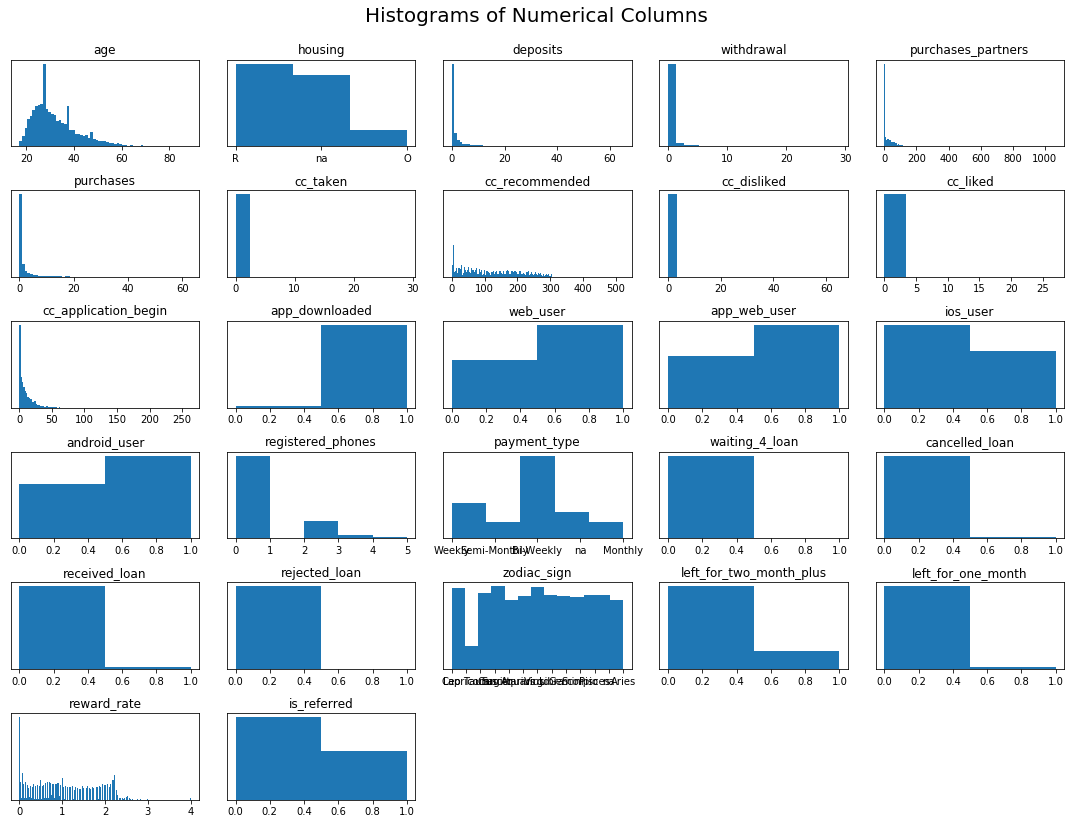
dataset2 = dataset[['housing', 'is_referred', 'app_downloaded',
'web_user', 'app_web_user', 'ios_user',
'android_user', 'registered_phones', 'payment_type',
'waiting_4_loan', 'cancelled_loan',
'received_loan', 'rejected_loan', 'zodiac_sign',
'left_for_two_month_plus', 'left_for_one_month', 'is_referred']]
fig = plt.figure(figsize=(15, 12))
plt.suptitle('Pie Chart Distributions', fontsize=20)
for i in range(1, dataset2.shape[1] + 1):
plt.subplot(6, 3, i)
f = plt.gca()
f.axes.get_yaxis().set_visible(False)
f.set_title(dataset2.columns.values[i - 1])
values = dataset2.iloc[:, i - 1].value_counts(normalize = True).values
index = dataset2.iloc[:, i - 1].value_counts(normalize = True).index
plt.pie(values, labels = index, autopct='%1.1f%%')
plt.axis('equal')
fig.tight_layout(rect=[0, 0.03, 1, 0.95])
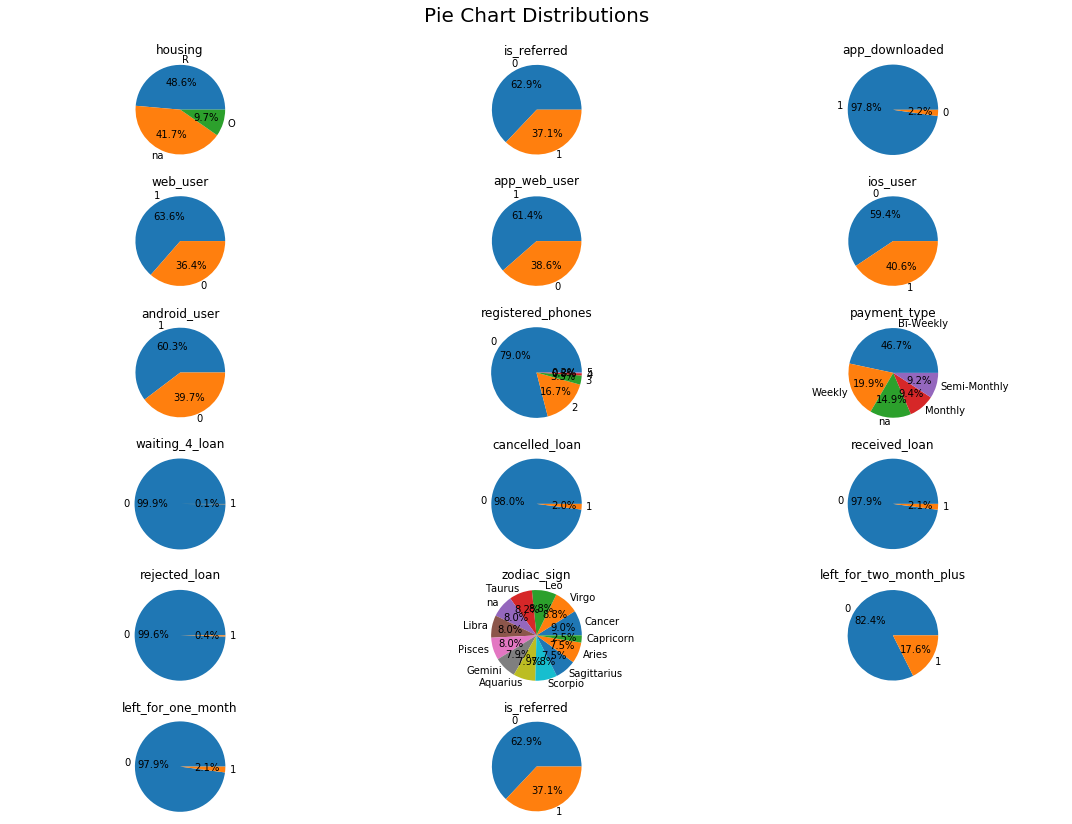
# Uneven features
df1= (dataset[dataset2.waiting_4_loan == 1].churn.value_counts()).to_frame()
df1["Name"] = 'waiting_4_loan'
df2= (dataset[dataset2.cancelled_loan == 1].churn.value_counts()).to_frame()
df2["Name"] = 'cancelled_loan'
df3= (dataset[dataset2.received_loan == 1].churn.value_counts()).to_frame()
df3["Name"] = 'received_loan'
df4= (dataset[dataset2.rejected_loan == 1].churn.value_counts()).to_frame()
df4["Name"] = 'rejected_loan'
df5= (dataset[dataset2.left_for_one_month == 1].churn.value_counts()).to_frame()
df5["Name"] = 'left_for_one_month'
df = pd.concat([df1, df2, df3, df4, df5])
df.reset_index(level=0, inplace=True)
df.columns = ['Churn_index', 'Churn_Count', 'Features']
## Visualize Uneven Features
fig = plt.figure()
g = sns.factorplot(x = 'Features', y='Churn_Count', hue = 'Churn_index',data=df, kind='bar')
g.set_xticklabels(rotation=90)
plt.show()
<Figure size 432x288 with 0 Axes>
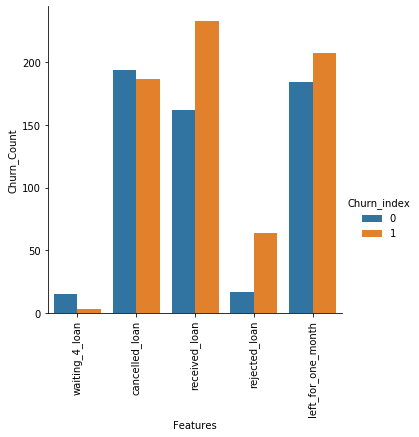
## Correlation with Response Variable
dataset.drop(columns = ['housing', 'payment_type',
'churn', 'zodiac_sign']
).corrwith(dataset.churn).plot.bar(figsize=(20,10),
title = 'Correlation with Response variable',
fontsize = 15, rot = 45,
color = sns.color_palette("muted"),
grid = True)
<matplotlib.axes._subplots.AxesSubplot at 0x1873b28ce80>
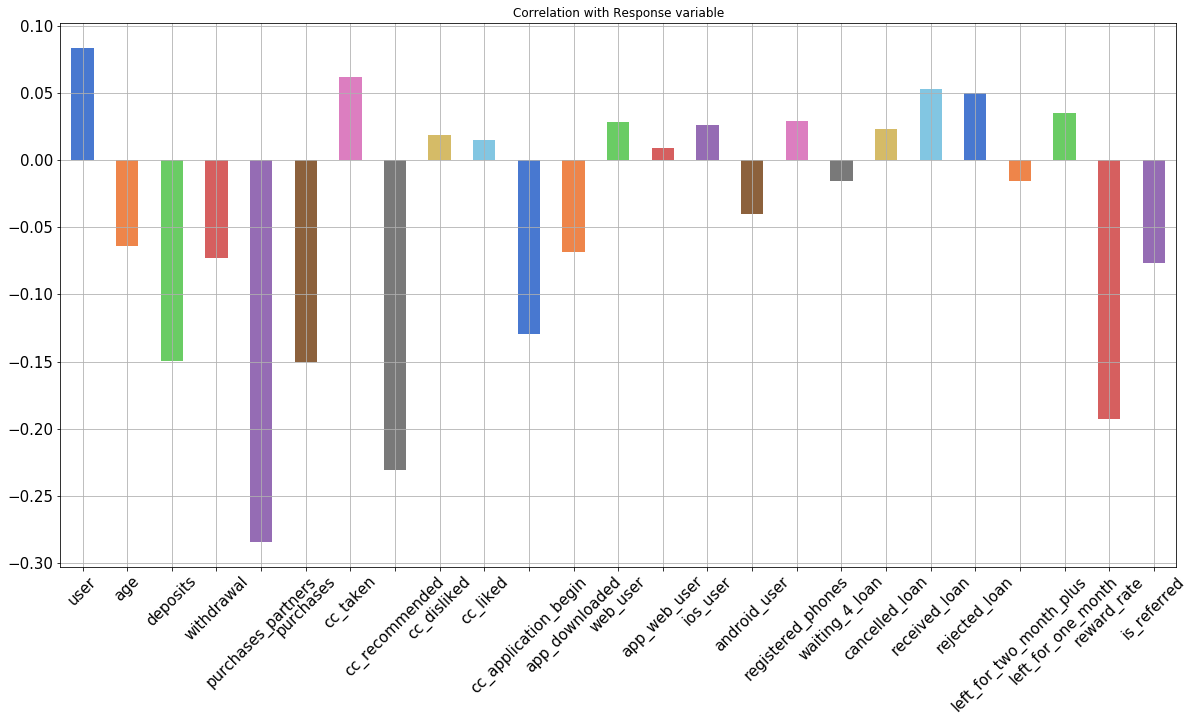
# Correlation Matrix
sns.set(style="white")
# Compute the correlation matrix
corr = dataset.drop(columns = ['user', 'churn']).corr()
# Generate a mask for the upper triangle
mask = np.zeros_like(corr, dtype=np.bool)
mask[np.triu_indices_from(mask)] = True
# Set up the matplotlib figure
f, ax = plt.subplots(figsize=(18, 15))
# Generate a custom diverging colormap
cmap = sns.diverging_palette(240, 10,n =9, sep=20, as_cmap=True)
# Draw the heatmap with the mask and correct aspect ratio
sns.heatmap(corr, mask=mask, cmap=cmap, vmax=.3, center=0,
square=True, linewidths=.5, cbar_kws={"shrink": .5})
<matplotlib.axes._subplots.AxesSubplot at 0x1873be18748>
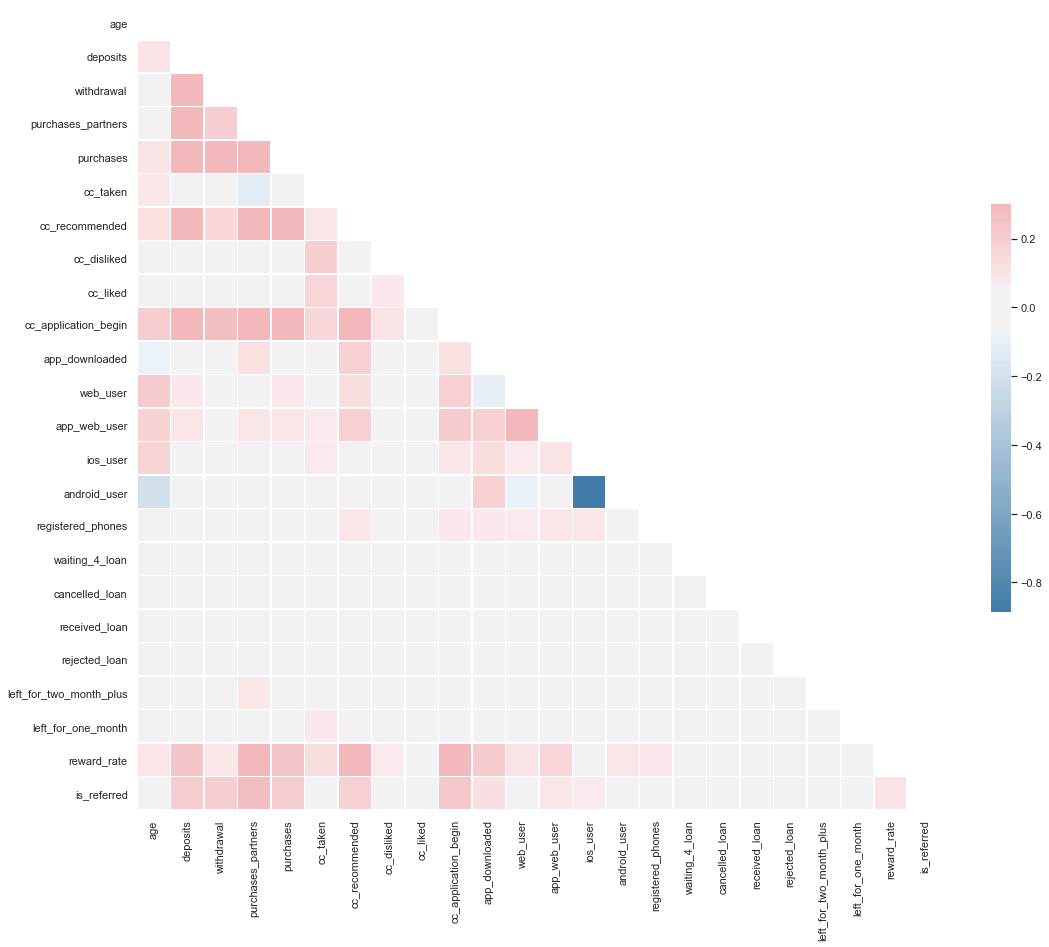
# Removing Correlated Fields
dataset = dataset.drop(columns = ['app_web_user'])
Note: Although there are somewhat correlated fields, they are not colinearThese feature are not functions of each other, so they won’t break the model. But these feature won’t help much either. Feature Selection should remove them.
4 Machine Learning
4.1 Data
Importing Libraries
#### Importing Libraries ####
import pandas as pd
import numpy as np
import random
import seaborn as sn
import matplotlib.pyplot as plt
import warnings
warnings.filterwarnings('ignore')
Data Preparation
## Data Preparation
user_identifier = dataset['user']
dataset = dataset.drop(columns = ['user'])
dataset.housing.value_counts()
R 9221
na 7910
O 1834
Name: housing, dtype: int64
dataset.groupby('housing')['churn'].nunique().reset_index()
| housing | churn | |
|---|---|---|
| 0 | O | 2 |
| 1 | R | 2 |
| 2 | na | 2 |
dataset = pd.get_dummies(dataset)
dataset.columns
Index(['churn', 'age', 'deposits', 'withdrawal', 'purchases_partners',
'purchases', 'cc_taken', 'cc_recommended', 'cc_disliked', 'cc_liked',
'cc_application_begin', 'app_downloaded', 'web_user', 'ios_user',
'android_user', 'registered_phones', 'waiting_4_loan', 'cancelled_loan',
'received_loan', 'rejected_loan', 'left_for_two_month_plus',
'left_for_one_month', 'reward_rate', 'is_referred', 'housing_O',
'housing_R', 'housing_na', 'payment_type_Bi-Weekly',
'payment_type_Monthly', 'payment_type_Semi-Monthly',
'payment_type_Weekly', 'payment_type_na', 'zodiac_sign_Aquarius',
'zodiac_sign_Aries', 'zodiac_sign_Cancer', 'zodiac_sign_Capricorn',
'zodiac_sign_Gemini', 'zodiac_sign_Leo', 'zodiac_sign_Libra',
'zodiac_sign_Pisces', 'zodiac_sign_Sagittarius', 'zodiac_sign_Scorpio',
'zodiac_sign_Taurus', 'zodiac_sign_Virgo', 'zodiac_sign_na'],
dtype='object')
dataset = dataset.drop(columns = ['housing_na', 'zodiac_sign_na', 'payment_type_na'])
dataset.columns
Index(['churn', 'age', 'deposits', 'withdrawal', 'purchases_partners',
'purchases', 'cc_taken', 'cc_recommended', 'cc_disliked', 'cc_liked',
'cc_application_begin', 'app_downloaded', 'web_user', 'ios_user',
'android_user', 'registered_phones', 'waiting_4_loan', 'cancelled_loan',
'received_loan', 'rejected_loan', 'left_for_two_month_plus',
'left_for_one_month', 'reward_rate', 'is_referred', 'housing_O',
'housing_R', 'payment_type_Bi-Weekly', 'payment_type_Monthly',
'payment_type_Semi-Monthly', 'payment_type_Weekly',
'zodiac_sign_Aquarius', 'zodiac_sign_Aries', 'zodiac_sign_Cancer',
'zodiac_sign_Capricorn', 'zodiac_sign_Gemini', 'zodiac_sign_Leo',
'zodiac_sign_Libra', 'zodiac_sign_Pisces', 'zodiac_sign_Sagittarius',
'zodiac_sign_Scorpio', 'zodiac_sign_Taurus', 'zodiac_sign_Virgo'],
dtype='object')
Training and Test Split set
# Splitting the dataset into the Training set and Test set
from sklearn.model_selection import train_test_split
X_train, X_test, y_train, y_test = train_test_split(dataset.drop(columns = 'churn'), dataset['churn'],
test_size = 0.2,
random_state = 0)
# Balancing the Training Set
y_train.value_counts()
0 8934
1 6238
Name: churn, dtype: int64
pos_index = y_train[y_train.values == 1].index
neg_index = y_train[y_train.values == 0].index
if len(pos_index) > len(neg_index):
higher = pos_index
lower = neg_index
else:
higher = neg_index
lower = pos_index
random.seed(0)
higher = np.random.choice(higher, size=len(lower))
lower = np.asarray(lower)
new_indexes = np.concatenate((lower, higher))
X_train = X_train.loc[new_indexes,]
y_train = y_train[new_indexes]
Feature Scaling
# Feature Scaling
from sklearn.preprocessing import StandardScaler
sc_X = StandardScaler()
X_train2 = pd.DataFrame(sc_X.fit_transform(X_train))
X_test2 = pd.DataFrame(sc_X.transform(X_test))
X_train2.columns = X_train.columns.values
X_test2.columns = X_test.columns.values
X_train2.index = X_train.index.values
X_test2.index = X_test.index.values
X_train = X_train2
X_test = X_test2
Generic Function to call Grid Search with multiple classifier
from sklearn.metrics import confusion_matrix
import itertools
import numpy as np
import matplotlib.pyplot as plt
from sklearn.metrics import confusion_matrix
plt.rcParams["font.family"] = 'DejaVu Sans'
def plot_confusion_matrix(cm, classes,
normalize=False,
title='Confusion matrix',
cmap=plt.cm.Blues):
if normalize:
cm = cm.astype('float') / cm.sum(axis=1)[:, np.newaxis]
plt.imshow(cm, interpolation='nearest', cmap=cmap)
plt.title(title)
plt.colorbar()
tick_marks = np.arange(len(classes))
plt.xticks(tick_marks, classes, rotation=90)
plt.yticks(tick_marks, classes)
fmt = '.2f' if normalize else 'd'
thresh = cm.max() / 2.
for i, j in itertools.product(range(cm.shape[0]), range(cm.shape[1])):
plt.text(j, i, format(cm[i, j], fmt),
horizontalalignment="center",
color="white" if cm[i, j] > thresh else "black")
plt.tight_layout()
plt.ylabel('True label')
plt.xlabel('Predicted label')
from datetime import datetime
def perform_model(model, X_train, y_train, X_test, y_test, class_labels, cm_normalize=True, \
print_cm=True, cm_cmap=plt.cm.Greens):
# to store results at various phases
results = dict()
# time at which model starts training
train_start_time = datetime.now()
print('training the model..')
model.fit(X_train, y_train)
print('Done \n \n')
train_end_time = datetime.now()
results['training_time'] = train_end_time - train_start_time
print('training_time(HH:MM:SS.ms) - {}\n\n'.format(results['training_time']))
# predict test data
print('Predicting test data')
test_start_time = datetime.now()
y_pred = model.predict(X_test)
test_end_time = datetime.now()
print('Done \n \n')
results['testing_time'] = test_end_time - test_start_time
print('testing time(HH:MM:SS:ms) - {}\n\n'.format(results['testing_time']))
results['predicted'] = y_pred
# calculate overall accuracty of the model
accuracy = metrics.accuracy_score(y_true=y_test, y_pred=y_pred)
# store accuracy in results
results['accuracy'] = accuracy
print('---------------------')
print('| Accuracy |')
print('---------------------')
print('\n {}\n\n'.format(accuracy))
# calculate f1-score of the model
f1_score = metrics.f1_score(y_true=y_test, y_pred=y_pred)
# store accuracy in results
results['f1_score'] = f1_score
print('---------------------')
print('| f1_score |')
print('---------------------')
print('\n {}\n\n'.format(f1_score))
# confusion matrix
cm = metrics.confusion_matrix(y_test, y_pred)
results['confusion_matrix'] = cm
if print_cm:
print('--------------------')
print('| Confusion Matrix |')
print('--------------------')
print('\n {}'.format(cm))
# plot confusin matrix
plt.figure(figsize=(9,9))
plt.grid(b=False)
plot_confusion_matrix(cm, classes=class_labels, normalize=True, title='Normalized confusion matrix', cmap = cm_cmap)
plt.show()
# get classification report
print('-------------------------')
print('| Classifiction Report |')
print('-------------------------')
classification_report = metrics.classification_report(y_test, y_pred)
# store report in results
results['classification_report'] = classification_report
print(classification_report)
# add the trained model to the results
results['model'] = model
return results
def print_grid_search_attributes(model):
# Estimator that gave highest score among all the estimators formed in GridSearch
print('--------------------------')
print('| Best Estimator |')
print('--------------------------')
print('\n\t{}\n'.format(model.best_estimator_))
# parameters that gave best results while performing grid search
print('--------------------------')
print('| Best parameters |')
print('--------------------------')
print('\tParameters of best estimator : \n\n\t{}\n'.format(model.best_params_))
# number of cross validation splits
print('---------------------------------')
print('| No of CrossValidation sets |')
print('--------------------------------')
print('\n\tTotal numbre of cross validation sets: {}\n'.format(model.n_splits_))
# Average cross validated score of the best estimator, from the Grid Search
print('--------------------------')
print('| Best Score |')
print('--------------------------')
print('\n\tAverage Cross Validate scores of best estimator : \n\n\t{}\n'.format(model.best_score_))
from sklearn import linear_model
from sklearn import metrics
from sklearn.model_selection import GridSearchCV
labels = ['No', 'Yes']
Logistic Regression
# start Grid search
import warnings
warnings.filterwarnings('ignore')
parameters = {'C':[0.01, 0.1, 1, 10, 20, 30], 'penalty':['l2','l1']}
log_reg = linear_model.LogisticRegression()
log_reg_grid = GridSearchCV(log_reg, param_grid=parameters, cv=3, verbose=1, n_jobs=-1)
log_reg_grid_results = perform_model(log_reg_grid, X_train, y_train, X_test, y_test, class_labels=labels)
training the model..
Fitting 3 folds for each of 12 candidates, totalling 36 fits
[Parallel(n_jobs=-1)]: Using backend LokyBackend with 8 concurrent workers.
[Parallel(n_jobs=-1)]: Done 36 out of 36 | elapsed: 7.3s finished
Done
training_time(HH:MM:SS.ms) - 0:00:07.655025
Predicting test data
Done
testing time(HH:MM:SS:ms) - 0:00:00.001999
---------------------
| Accuracy |
---------------------
0.6430266279989454
---------------------
| f1_score |
---------------------
0.6414194915254238
--------------------
| Confusion Matrix |
--------------------
[[1228 999]
[ 355 1211]]
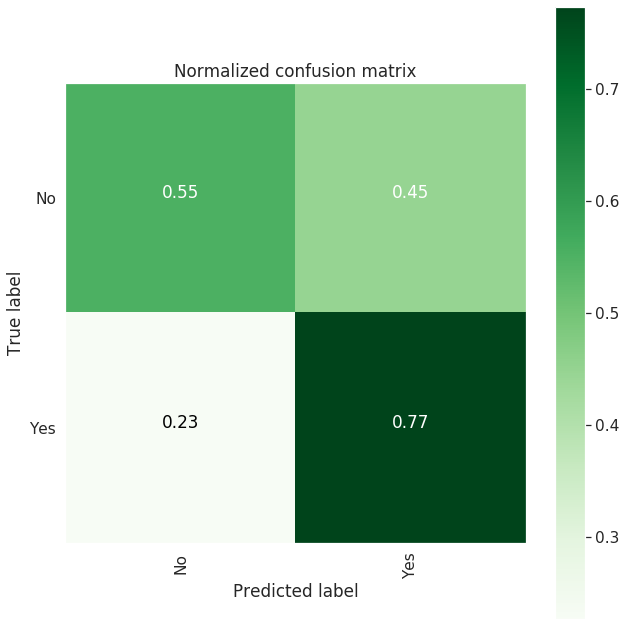
-------------------------
| Classifiction Report |
-------------------------
precision recall f1-score support
0 0.78 0.55 0.64 2227
1 0.55 0.77 0.64 1566
accuracy 0.64 3793
macro avg 0.66 0.66 0.64 3793
weighted avg 0.68 0.64 0.64 3793
# observe the attributes of the model
print_grid_search_attributes(log_reg_grid_results['model'])
--------------------------
| Best Estimator |
--------------------------
LogisticRegression(C=0.1, class_weight=None, dual=False, fit_intercept=True,
intercept_scaling=1, l1_ratio=None, max_iter=100,
multi_class='warn', n_jobs=None, penalty='l1',
random_state=None, solver='warn', tol=0.0001, verbose=0,
warm_start=False)
--------------------------
| Best parameters |
--------------------------
Parameters of best estimator :
{'C': 0.1, 'penalty': 'l1'}
---------------------------------
| No of CrossValidation sets |
--------------------------------
Total numbre of cross validation sets: 3
--------------------------
| Best Score |
--------------------------
Average Cross Validate scores of best estimator :
0.6550176338570054
Linear SVC
from sklearn.svm import LinearSVC
parameters = {'C':[0.125, 0.5, 1, 2, 8, 16]}
lr_svc = LinearSVC()
lr_svc_grid = GridSearchCV(lr_svc, param_grid=parameters, n_jobs=-1, verbose=1)
lr_svc_grid_results = perform_model(lr_svc_grid, X_train, y_train, X_test, y_test, class_labels=labels)
training the model..
Fitting 3 folds for each of 6 candidates, totalling 18 fits
[Parallel(n_jobs=-1)]: Using backend LokyBackend with 8 concurrent workers.
[Parallel(n_jobs=-1)]: Done 18 out of 18 | elapsed: 13.1s finished
Done
training_time(HH:MM:SS.ms) - 0:00:16.869027
Predicting test data
Done
testing time(HH:MM:SS:ms) - 0:00:00.000971
---------------------
| Accuracy |
---------------------
0.6353809649354073
---------------------
| f1_score |
---------------------
0.6349960411718131
--------------------
| Confusion Matrix |
--------------------
[[1207 1020]
[ 363 1203]]
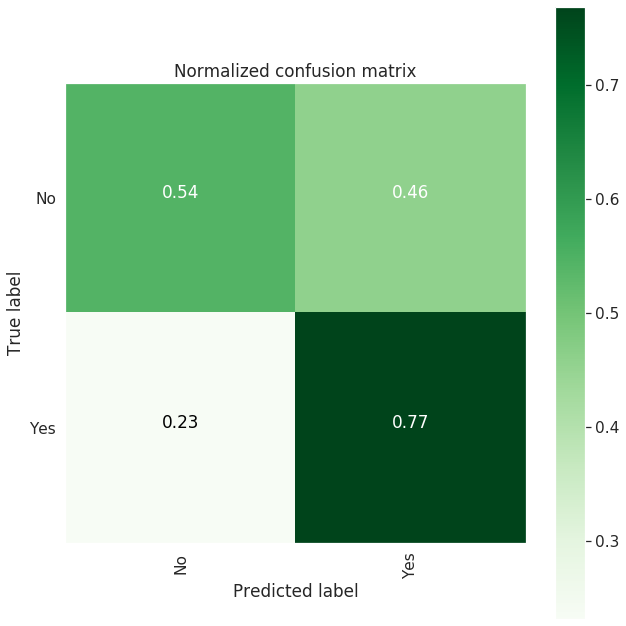
-------------------------
| Classifiction Report |
-------------------------
precision recall f1-score support
0 0.77 0.54 0.64 2227
1 0.54 0.77 0.63 1566
accuracy 0.64 3793
macro avg 0.65 0.66 0.64 3793
weighted avg 0.67 0.64 0.64 3793
print_grid_search_attributes(lr_svc_grid_results['model'])
--------------------------
| Best Estimator |
--------------------------
LinearSVC(C=0.125, class_weight=None, dual=True, fit_intercept=True,
intercept_scaling=1, loss='squared_hinge', max_iter=1000,
multi_class='ovr', penalty='l2', random_state=None, tol=0.0001,
verbose=0)
--------------------------
| Best parameters |
--------------------------
Parameters of best estimator :
{'C': 0.125}
---------------------------------
| No of CrossValidation sets |
--------------------------------
Total numbre of cross validation sets: 3
--------------------------
| Best Score |
--------------------------
Average Cross Validate scores of best estimator :
0.6533344020519397
Kernal SVM with GridSearch
from sklearn.svm import SVC
parameters = {'C':[2,8,16],\
'gamma': [ 0.0078125, 0.125, 2]}
rbf_svm = SVC(kernel='rbf')
rbf_svm_grid = GridSearchCV(rbf_svm,param_grid=parameters, n_jobs=-1)
rbf_svm_grid_results = perform_model(rbf_svm_grid, X_train, y_train, X_test, y_test, class_labels=labels)
training the model..
Done
training_time(HH:MM:SS.ms) - 0:01:44.801175
Predicting test data
Done
testing time(HH:MM:SS:ms) - 0:00:02.137951
---------------------
| Accuracy |
---------------------
0.4932770893751648
---------------------
| f1_score |
---------------------
0.6022350993377484
--------------------
| Confusion Matrix |
--------------------
[[ 416 1811]
[ 111 1455]]
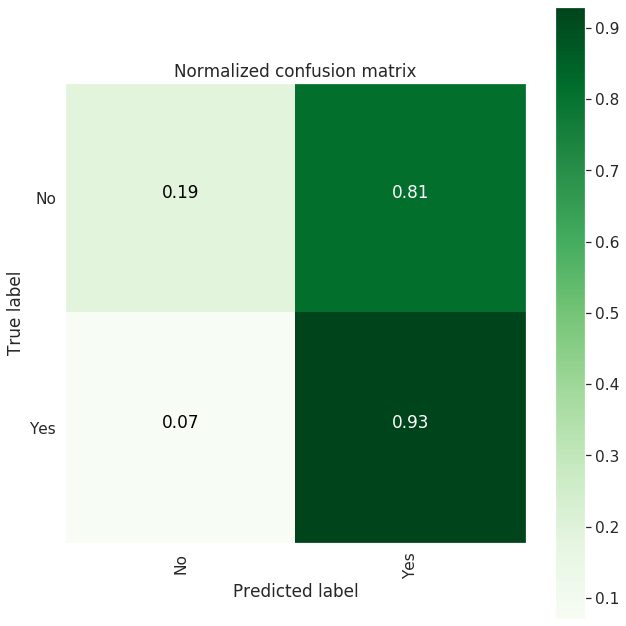
-------------------------
| Classifiction Report |
-------------------------
precision recall f1-score support
0 0.79 0.19 0.30 2227
1 0.45 0.93 0.60 1566
accuracy 0.49 3793
macro avg 0.62 0.56 0.45 3793
weighted avg 0.65 0.49 0.43 3793
print_grid_search_attributes(rbf_svm_grid_results['model'])
--------------------------
| Best Estimator |
--------------------------
SVC(C=8, cache_size=200, class_weight=None, coef0=0.0,
decision_function_shape='ovr', degree=3, gamma=2, kernel='rbf', max_iter=-1,
probability=False, random_state=None, shrinking=True, tol=0.001,
verbose=False)
--------------------------
| Best parameters |
--------------------------
Parameters of best estimator :
{'C': 8, 'gamma': 2}
---------------------------------
| No of CrossValidation sets |
--------------------------------
Total numbre of cross validation sets: 3
--------------------------
| Best Score |
--------------------------
Average Cross Validate scores of best estimator :
0.6999839692209041
Decision Tree with Grid Search
from sklearn.tree import DecisionTreeClassifier
parameters = {'max_depth':np.arange(3,10,2)}
dt = DecisionTreeClassifier()
dt_grid = GridSearchCV(dt,param_grid=parameters, n_jobs=-1)
dt_grid_results = perform_model(dt_grid, X_train, y_train, X_test, y_test, class_labels=labels)
print_grid_search_attributes(dt_grid_results['model'])
training the model..
Done
training_time(HH:MM:SS.ms) - 0:00:00.224999
Predicting test data
Done
testing time(HH:MM:SS:ms) - 0:00:00.002001
---------------------
| Accuracy |
---------------------
0.6867914579488531
---------------------
| f1_score |
---------------------
0.6455847255369928
--------------------
| Confusion Matrix |
--------------------
[[1523 704]
[ 484 1082]]
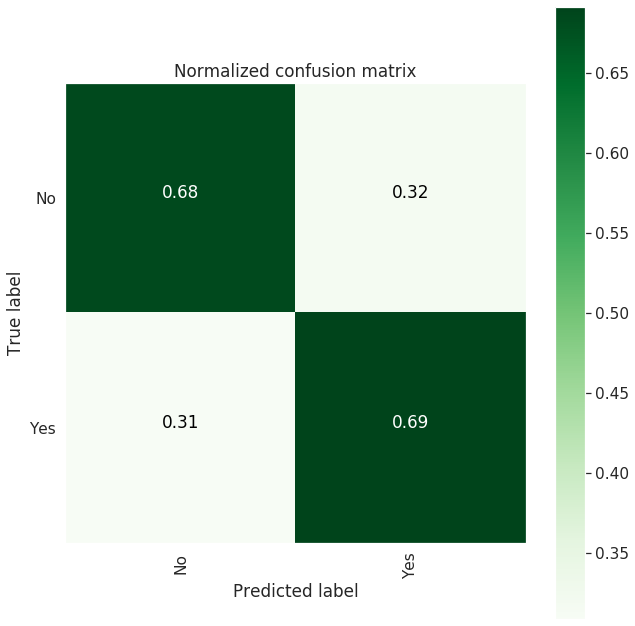
-------------------------
| Classifiction Report |
-------------------------
precision recall f1-score support
0 0.76 0.68 0.72 2227
1 0.61 0.69 0.65 1566
accuracy 0.69 3793
macro avg 0.68 0.69 0.68 3793
weighted avg 0.70 0.69 0.69 3793
--------------------------
| Best Estimator |
--------------------------
DecisionTreeClassifier(class_weight=None, criterion='gini', max_depth=9,
max_features=None, max_leaf_nodes=None,
min_impurity_decrease=0.0, min_impurity_split=None,
min_samples_leaf=1, min_samples_split=2,
min_weight_fraction_leaf=0.0, presort=False,
random_state=None, splitter='best')
--------------------------
| Best parameters |
--------------------------
Parameters of best estimator :
{'max_depth': 9}
---------------------------------
| No of CrossValidation sets |
--------------------------------
Total numbre of cross validation sets: 3
--------------------------
| Best Score |
--------------------------
Average Cross Validate scores of best estimator :
0.6878807310035268
print_grid_search_attributes(dt_grid_results['model'])
--------------------------
| Best Estimator |
--------------------------
DecisionTreeClassifier(class_weight=None, criterion='gini', max_depth=9,
max_features=None, max_leaf_nodes=None,
min_impurity_decrease=0.0, min_impurity_split=None,
min_samples_leaf=1, min_samples_split=2,
min_weight_fraction_leaf=0.0, presort=False,
random_state=None, splitter='best')
--------------------------
| Best parameters |
--------------------------
Parameters of best estimator :
{'max_depth': 9}
---------------------------------
| No of CrossValidation sets |
--------------------------------
Total numbre of cross validation sets: 3
--------------------------
| Best Score |
--------------------------
Average Cross Validate scores of best estimator :
0.6878807310035268
#Random Forest with Grid Search
from sklearn.ensemble import RandomForestClassifier
params = {'n_estimators': np.arange(10,201,20), 'max_depth':np.arange(3,15,2)}
rfc = RandomForestClassifier()
rfc_grid = GridSearchCV(rfc, param_grid=params, n_jobs=-1)
rfc_grid_results = perform_model(rfc_grid, X_train, y_train, X_test, y_test, class_labels=labels)
print_grid_search_attributes(rfc_grid_results['model'])
training the model..
Done
training_time(HH:MM:SS.ms) - 0:00:34.146021
Predicting test data
Done
testing time(HH:MM:SS:ms) - 0:00:00.063967
---------------------
| Accuracy |
---------------------
0.6925916161349855
---------------------
| f1_score |
---------------------
0.673389355742297
--------------------
| Confusion Matrix |
--------------------
[[1425 802]
[ 364 1202]]
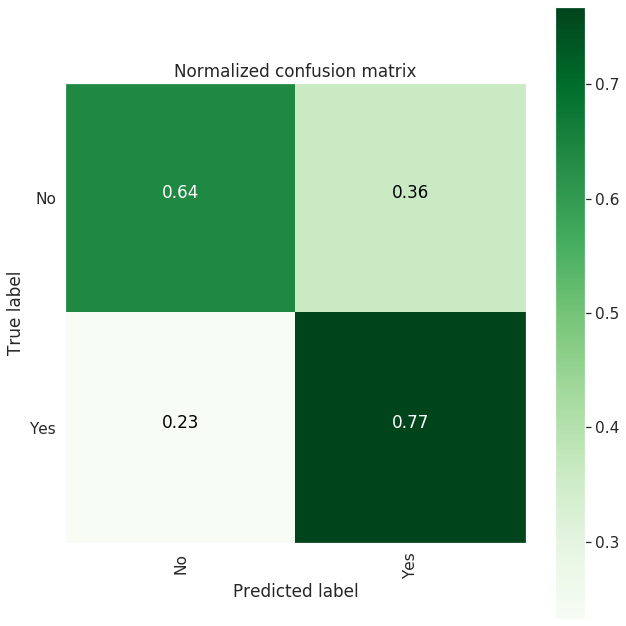
-------------------------
| Classifiction Report |
-------------------------
precision recall f1-score support
0 0.80 0.64 0.71 2227
1 0.60 0.77 0.67 1566
accuracy 0.69 3793
macro avg 0.70 0.70 0.69 3793
weighted avg 0.72 0.69 0.69 3793
--------------------------
| Best Estimator |
--------------------------
RandomForestClassifier(bootstrap=True, class_weight=None, criterion='gini',
max_depth=13, max_features='auto', max_leaf_nodes=None,
min_impurity_decrease=0.0, min_impurity_split=None,
min_samples_leaf=1, min_samples_split=2,
min_weight_fraction_leaf=0.0, n_estimators=110,
n_jobs=None, oob_score=False, random_state=None,
verbose=0, warm_start=False)
--------------------------
| Best parameters |
--------------------------
Parameters of best estimator :
{'max_depth': 13, 'n_estimators': 110}
---------------------------------
| No of CrossValidation sets |
--------------------------------
Total numbre of cross validation sets: 3
--------------------------
| Best Score |
--------------------------
Average Cross Validate scores of best estimator :
0.737976915678102
Gradient Boosting with Grid Search
from sklearn.ensemble import GradientBoostingClassifier
param_grid = {'max_depth': np.arange(5,8,1), \
'n_estimators':np.arange(130,170,10)}
gbdt = GradientBoostingClassifier()
gbdt_grid = GridSearchCV(gbdt, param_grid=param_grid, n_jobs=-1)
gbdt_grid_results = perform_model(gbdt_grid, X_train, y_train, X_test, y_test, class_labels=labels)
print_grid_search_attributes(gbdt_grid_results['model'])
training the model..
Done
training_time(HH:MM:SS.ms) - 0:01:15.668046
Predicting test data
Done
testing time(HH:MM:SS:ms) - 0:00:00.019998
---------------------
| Accuracy |
---------------------
0.7044555760611653
---------------------
| f1_score |
---------------------
0.6779661016949152
--------------------
| Confusion Matrix |
--------------------
[[1492 735]
[ 386 1180]]
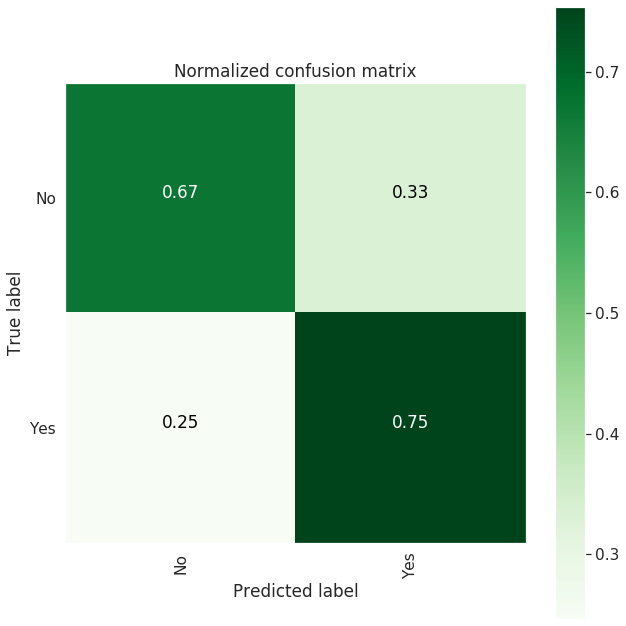
-------------------------
| Classifiction Report |
-------------------------
precision recall f1-score support
0 0.79 0.67 0.73 2227
1 0.62 0.75 0.68 1566
accuracy 0.70 3793
macro avg 0.71 0.71 0.70 3793
weighted avg 0.72 0.70 0.71 3793
--------------------------
| Best Estimator |
--------------------------
GradientBoostingClassifier(criterion='friedman_mse', init=None,
learning_rate=0.1, loss='deviance', max_depth=7,
max_features=None, max_leaf_nodes=None,
min_impurity_decrease=0.0, min_impurity_split=None,
min_samples_leaf=1, min_samples_split=2,
min_weight_fraction_leaf=0.0, n_estimators=150,
n_iter_no_change=None, presort='auto',
random_state=None, subsample=1.0, tol=0.0001,
validation_fraction=0.1, verbose=0,
warm_start=False)
--------------------------
| Best parameters |
--------------------------
Parameters of best estimator :
{'max_depth': 7, 'n_estimators': 150}
---------------------------------
| No of CrossValidation sets |
--------------------------------
Total numbre of cross validation sets: 3
--------------------------
| Best Score |
--------------------------
Average Cross Validate scores of best estimator :
0.746232766912472
## Xgboost
from xgboost import XGBClassifier
param_grid = {
'min_child_weight': [1, 5],
'gamma': [0.5, 1],
'subsample': [0.6],
'colsample_bytree': [0.6, 0.8],
'max_depth': [3, 4]
}
xgboost = XGBClassifier(learning_rate=0.02, n_estimators=100, objective='binary:logistic',
silent=True, nthread=1)
xgboost_grid = GridSearchCV(xgboost, param_grid=param_grid, n_jobs=-1)
xgboost_grid_results = perform_model(xgboost_grid, X_train, y_train, X_test, y_test, class_labels=labels)
print_grid_search_attributes(xgboost_grid_results['model'])
training the model..
Done
training_time(HH:MM:SS.ms) - 0:00:20.966037
Predicting test data
Done
testing time(HH:MM:SS:ms) - 0:00:00.016998
---------------------
| Accuracy |
---------------------
0.6767730029000791
---------------------
| f1_score |
---------------------
0.6528878822197055
--------------------
| Confusion Matrix |
--------------------
[[1414 813]
[ 413 1153]]
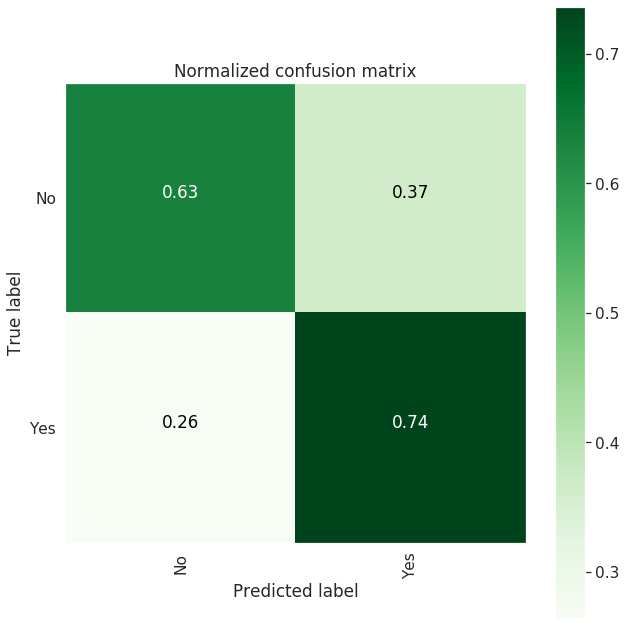
-------------------------
| Classifiction Report |
-------------------------
precision recall f1-score support
0 0.77 0.63 0.70 2227
1 0.59 0.74 0.65 1566
accuracy 0.68 3793
macro avg 0.68 0.69 0.68 3793
weighted avg 0.70 0.68 0.68 3793
--------------------------
| Best Estimator |
--------------------------
XGBClassifier(base_score=0.5, booster='gbtree', colsample_bylevel=1,
colsample_bynode=1, colsample_bytree=0.8, gamma=1,
learning_rate=0.02, max_delta_step=0, max_depth=4,
min_child_weight=5, missing=None, n_estimators=100, n_jobs=1,
nthread=1, objective='binary:logistic', random_state=0,
reg_alpha=0, reg_lambda=1, scale_pos_weight=1, seed=None,
silent=True, subsample=0.6, verbosity=1)
--------------------------
| Best parameters |
--------------------------
Parameters of best estimator :
{'colsample_bytree': 0.8, 'gamma': 1, 'max_depth': 4, 'min_child_weight': 5, 'subsample': 0.6}
---------------------------------
| No of CrossValidation sets |
--------------------------------
Total numbre of cross validation sets: 3
--------------------------
| Best Score |
--------------------------
Average Cross Validate scores of best estimator :
0.6892433472266752
Compare Results
print('\n Accuracy F1-score Error')
print(' ---------- --------- --------')
print('Logistic Regression : {:.04}% {:.04}% {:.04}%'.format(log_reg_grid_results['accuracy'] * 100,\
log_reg_grid_results['f1_score'] * 100,\
100-(log_reg_grid_results['accuracy'] * 100)))
print('Linear SVC : {:.04}% {:.04}% {:.04}% '.format(lr_svc_grid_results['accuracy'] * 100,\
lr_svc_grid_results['f1_score'] * 100,\
100-(lr_svc_grid_results['accuracy'] * 100)))
print('rbf SVM classifier : {:.04}% {:.04}% {:.04}% '.format(rbf_svm_grid_results['accuracy'] * 100,\
rbf_svm_grid_results['f1_score'] * 100,\
100-(rbf_svm_grid_results['accuracy'] * 100)))
print('DecisionTree : {:.04}% {:.04}% {:.04}% '.format(dt_grid_results['accuracy'] * 100,\
dt_grid_results['f1_score'] * 100,\
100-(dt_grid_results['accuracy'] * 100)))
print('Random Forest : {:.04}% {:.04}% {:.04}% '.format(rfc_grid_results['accuracy'] * 100,\
rfc_grid_results['f1_score'] * 100,\
100-(rfc_grid_results['accuracy'] * 100)))
print('GradientBoosting DT : {:.04}% {:.04}% {:.04}% '.format(rfc_grid_results['accuracy'] * 100,\
rfc_grid_results['f1_score'] * 100,\
100-(rfc_grid_results['accuracy'] * 100)))
print('Xgboost : {:.04}% {:.04}% {:.04}% '.format(xgboost_grid_results['accuracy'] * 100,\
xgboost_grid_results['f1_score'] * 100,\
100-(xgboost_grid_results['accuracy'] * 100)))
Accuracy F1-score Error
---------- --------- --------
Logistic Regression : 64.3% 64.14% 35.7%
Linear SVC : 63.54% 63.5% 36.46%
rbf SVM classifier : 49.33% 60.22% 50.67%
DecisionTree : 68.68% 64.56% 31.32%
Random Forest : 69.26% 67.34% 30.74%
GradientBoosting DT : 69.26% 67.34% 30.74%
XGBOOST : 67.68% 65.29% 32.32%
5 Conclusion
Our model provides an indication of which users are likely to churn. I have purposely left the date of the expected churn open-ended.The reason we are not aiming to create new products for people who are going to leave us for sure, but for people who are starting to lose interest in the app.
I would like to include the time it takes for churn - Survival analysis in the next project with possibly different data set to showcase different acceptance of problem-solving skills. Also, we have open-ended emphasis to get a sense of bit-likely customer likely to churn.
6 Next Steps
- To include, Interpretability - Local Surrogate (LIME) or Individual Conditional Expectation (ICE)
- Add additional features like Session details, session duration etc.

